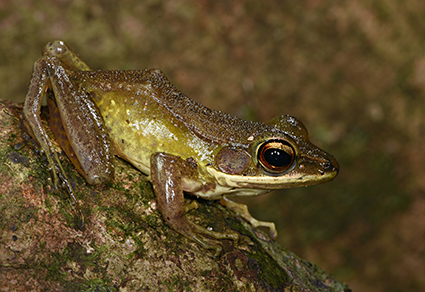Abstract
The distribution of the White-Lipped Frog Amnirana albolabris was long assumed to extend from eastern-central to western African rainforests. However, recent molecular phylogenetic analyses revealed that this taxon likely represents several undescribed species. Because the name-bearing types were collected in Gabon, the distantly related West African populations clearly represent an undescribed species that partly occurs in sympatry with Amnirana fonensis. Based on an integrative taxonomic approach, including molecular, morphological, and acoustic data, we describe the ‘albolabris’ populations from the Upper Guinean Forest Zone as a new species, and redescribe the morphologically similar A. fonensis on the bases of a larger series of genotyped individuals, including the first known females. We also provide new biological information for A. fonensis, including their advertisement call, habitat, and reproductive data. The new species is sister to A. fonensis and the two species differ by 5.8% in the mitochondrial 16S ribosomal RNA gene. Morphologically, males of the new species are smaller and have relatively smaller humeral glands. Females of the new species seem to have shorter legs than A. fonensis. In comparison to A. fonensis, the advertisement call of the new species has a higher dominant frequency and more pronounced frequency modulation. The two species differ in their distribution and habitat preferences, as revealed by environmental niche modelling. Whereas the new species is restricted to the Upper Guinean forests and thus is a true lowland-rainforest inhabitant, A. fonensis lives predominantly in Guinean montane forests in the forest-savanna mosaic zone.
References
Barej, M.F., Penner, J., Schmitz, A. & Rödel, M.-O. (2015) Multiple genetic lineages challenge the monospecific status of the West African endemic frog family Odontobatrachidae. BMC Evolutionary Biology, 15, 67. https://doi.org/10.1186/s12862-015-0346-9
DOI: https://doi.org/10.1371/journal.pone.0056236
Penner, J., Adum, G.B., McElroy, M.T., Doherty-Bone, T., Hirschfeld, M., Sandberger, L., Weldon, C., Cunningham, A.A., Ohst, T., Wombwell, E., Portik, D.M., Reid, D., Hillers, H., Ofori-Boateng, C., Oduro, W., Plötner, J., Ohler, A., Leaché, A.D. & Rödel, M.-O. (2013) West Africa - A safe haven for frogs? A sub-continental assessment of the chytrid fungus (Batrachochytrium dendrobatidis). PLoS ONE, 8, e56236. https://doi.org/10.1371/journal.pone.0056236


